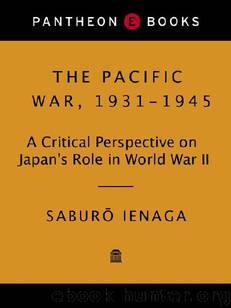Pacific War, 1931-1945 (Pantheon Asia Library) by Saburo Ienaga

Author:Saburo Ienaga [Ienaga, Saburo]
Language: eng
Format: epub
ISBN: 9780307756091
Publisher: Knopf Doubleday Publishing Group
Published: 2010-06-05T04:00:00+00:00
China Proper
The Imperial Army’s occupation of the cities of northern and central China brought the region under Japanese economic control. Use of the puppet East Hopei Anti-Communist Autonomous Council for smuggling was an early indication of what was in store for China. The East Hopei region “began to look like a smuggling base for heroin and other items sent in from Manchuria and Kwantung.” According to Yamauchi Saburō, president of the South Manchurian Pharmaceutical Company, the firm began producing a large quantity of heroin in 1933 and distributed it with “safepassage documents” provided by the Kempeitai. The major heroin dealers showed their appreciation for army protection by contributing funds to purchase military airplanes. When the war spread across China, Fujita Isamu imported heroin worth about $10 million from Persia and sold it in Shanghai. He earned almost 50 million for the Japanese army, which badly needed the funds.58 The opium trade carried out under Japanese army auspices wreaked havoc on the Chinese.
New companies like the North China Development Company and the Central China Promotion Company proliferated with the spread of hostilities. Carpetbaggers rushed into the occupied areas to seize Chinese property in a frenetic bid to “develop” China. The Chinese soon found that “Japan-China friendship means a kind of economic cooperation more dangerous than being shot at by the Japanese army.”59 In his 1941 work Senji kokusaihō kōgi (Lectures on International Law in Wartime), Shinobu Junpei states that “enemy property” administered by the army in 1940 included a great variety of factories. There were twenty different kinds in 110 places in north China and twenty-seven categories of factories at 94 locations in central China. Shinobu defended the control of enemy property as a “temporary measure” to prevent its ruin while the owners were absent. However, the practice violated Article 46 of the Hague Convention, which required safeguards for private property.
Japanese forces openly plundered Chinese property. Troops marching into Paoting after its surrender “broke store windows, grabbed valuables, and draped the loot across their rifles.”60 In the rice-rich lower Yangtze River delta, Chinese peasants worked months in the paddy muck only to see the crop hauled away in Japanese trucks, often to already bulging army warehouses where it rotted.61 Japanese troops shot water buffaloes for food, although the beasts were the only means old peasant women had of farming their fields and avoiding starvation.62
Rape was an accepted prerogative of the Imperial Army. Gomi Kōsuke, an enlisted man, saw a veteran soldier attack a Chinese woman during a short rest break. To save time, the soldier mounted the woman in full uniform with all his ammunition and gear. He pumped away while she screamed.63 Tamura Taijirō’s Rajo no iru tairetsu (Naked Women in the Ranks) has many provocative passages about sexual conduct. One soldier says to another, “I’ve been told that if our unit goes out on a combat mission, it’s all right to rape the women we find. They say the raped women must always be killed.” In another section, a
Download
This site does not store any files on its server. We only index and link to content provided by other sites. Please contact the content providers to delete copyright contents if any and email us, we'll remove relevant links or contents immediately.
| Africa | Americas |
| Arctic & Antarctica | Asia |
| Australia & Oceania | Europe |
| Middle East | Russia |
| United States | World |
| Ancient Civilizations | Military |
| Historical Study & Educational Resources |
The Tale of Genji (unabridged) by Shikibu Murasaki(1011)
Japan by Edwin Reischauer(919)
The Complete Guide to Japanese Drinks by Stephen Lyman & Chris Bunting(900)
Shogun by James Clavell(842)
Native American in the Land of the Shogun: Ranald MacDonald and the Opening of Japan by Frederik L. Schodt(778)
The Pacific War by Robert O'Neill(774)
Japanese Notebooks by Igort(769)
Shogun (The Asian Saga Chronology) by James Clavell(726)
Japanese Candlestick Charting by Steve Nison(726)
Last Mission to Tokyo by Michel Paradis(717)
Bushido Explained by Alexander Bennett(700)
The Pillow Book by Sei Shonagon(696)
The Dutch Encounter with Tokugawa Japan by Adam Clulow(695)
The Great Road by Smedley Agnes;(685)
Ninja Fighting Techniques by Stephen K. Hayes(677)
Last Mission to Tokyo: The Extraordinary Story of the Doolittle Raiders and Their Final Fight for Justice by Michel Paradis(637)
Underground: The Tokyo Gas Attack and the Japanese Psyche by Haruki Murakami(632)
People Who Eat Darkness by Richard Lloyd Parry(618)
Comfort Woman by Maria Rosa Henson(616)
